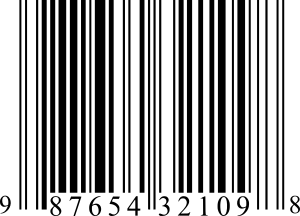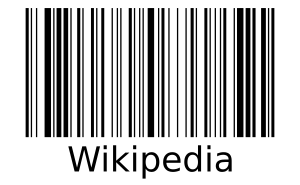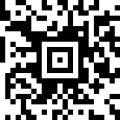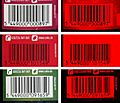Barcode facts for kids
A barcode is a special picture made of lines and spaces, or sometimes dots. It holds information, usually numbers, that a computer can read very quickly. The first barcodes used only lines, which looked like bars.
Barcodes were first used to keep track of train cars. They became very popular when supermarkets started using them at checkout. The very first product scanned with a barcode was a pack of Wrigley's Juicy Fruit Gum on June 26, 1974. An IBM engineer named George J. Laurer helped invent it. Today, barcodes are used for many different things.
Contents
History of Barcodes
Norman Joseph Woodland and Bernard Silver created the modern barcode idea. They received a patent for it in 1952. Their goal was to make checking out items easier. Their code was inspired by Morse code.
In 1959, David Collins developed a system to track railroad cars using barcodes. This system did not work well because dirt often covered the barcodes. It was stopped in the 1970s. Later, in the 1980s, a similar system using radio tags was introduced.
How Barcodes Are Designed
There are different types of barcodes, each with its own design:
- One-dimensional (1D) barcodes: These older designs use the width and spacing of lines. They store numbers. Examples include the European Article Number and the Universal Product Code.
- Two-dimensional (2D) barcodes: These newer designs use black and white dots or squares. They can store much more information than 1D codes. Examples are QR codes, Aztec Code, and BeeTagg.
A standard 1D barcode uses changes in lines and spaces to store numbers. A special machine called a scanner reads these lines. The scanner then turns the lines into numbers that a computer understands. These barcodes are designed so they can be read forwards or backwards. This means you don't have to worry about how you hold the product in front of the scanner. A laser line is often used to scan them. These are called barcode readers. Since the laser scans in one direction (left or right), they are called 1D barcodes.
Newer 2D systems use different shapes, not just bars. They can hold a lot more information. But they still need to be scanned in two directions: left or right, and up or down. QR codes were invented in 1994. They were first used in factories to track parts. Now, people use them for many things. Special software can read QR codes from an image. Smartphones can even have apps to read them. This is very popular for getting information from websites or special resources. For example, some cities use them to help people find things. Many tickets, like those for buses or concerts, also have QR codes.
What Barcodes Are Used For
Barcodes, especially the Universal Product Code (UPC), are a big part of modern life. They are used in many places, and the technology keeps getting better. Here are some common uses:
- Shopping: Almost every item you buy in a store has a UPC barcode. This helps stores keep track of many items. It also makes checkout faster.
- Healthcare: Hospitals use barcodes to identify patients. This helps doctors and nurses track patients and their medical history safely.
- Tracking things: Barcodes help track things that move. This includes rental cars, airline luggage, train cars, and mail.
- Travel: Since 2005, airlines have used 2D barcodes on boarding passes. This makes boarding planes quicker.
- Entertainment: Many tickets for sports games, movies, theaters, and fairs have barcodes. You scan the barcode to enter.
Benefits of Using Barcodes
Using barcodes can help businesses a lot. For example:
- Stock management: Stores can know exactly what they have in stock. They can order new items before they run out.
- Easy pricing: Price changes can be updated once in the computer. Cashiers don't need to remember sale prices.
- Sales trends: Businesses can track how products sell over time. This helps them guess what people will buy during different seasons.
- Customer insights: If you use a company's loyalty card, the company can track your buying habits. This helps them offer you things you might like.
- Machine data: Barcodes can also store data from machines.
Example images
- Barcode Samples
-
Lorem ipsum boilerplate text as four segment Data matrix
-
"This is an example Aztec symbol for Wikipedia" encoded in Aztec code data matrix
Images for kids
-
A snack vendor on the Shinkansen train scans a barcode.
See also
 In Spanish: Código de barras para niños
In Spanish: Código de barras para niños
















